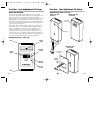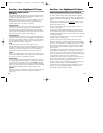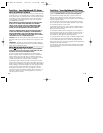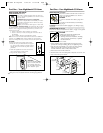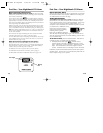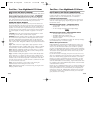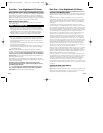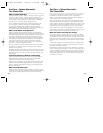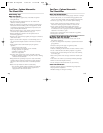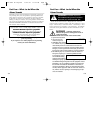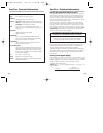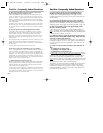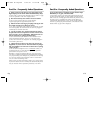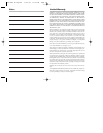
Part Six – Frequently Asked Questions
Q. How many alarms do I need in my house? How much
square footage will one CO alarm cover?
A. We recommend you place alarms near the sleeping area(s). If
you have a multi-level home, you should place an alarm on each
level of the home. A good rule of thumb for the number and place-
ment of CO alarms for your particular home is to place CO alarms
near smoke alarms that have been installed to meet current building
code requirements.
Generally, one CO alarm can be adequate for 1,200 to 1,500 square
feet of living space. The most important determination for the num-
ber of alarms needed is whether an alarm can be heard in all sleep-
ing areas.
Q. Can you explain what “time-weighted alarm” means?
A. Because carbon monoxide is a cumulative poison, two factors
determine how the body is affected by CO: the level of exposure
and the length of exposure. For example, being continuously
exposed to low levels of carbon monoxide for many hours can be
as dangerous as being exposed to higher levels of CO for a short
period of time.
The microchip inside your Nighthawk CO alarm monitors the air for
the presence of carbon monoxide and computes the levels and
length of exposure, alarming when you should be concerned about
CO exposure.
For more information about the alarm, see page 5-2.
Q. Do I have to press the test button to get a CO reading?
A. No. Your Nighthawk CO alarm continuously monitors the air for
carbon monoxide. An updated reading is shown on the digital dis-
play every 15 seconds. If there is no CO present, the digital display
will show a zero. The CO alarm will alert you to the presence of CO
automatically. To test the internal components and circuitry of your
CO alarm, press the Test/Reset button. For complete instructions on
testing your CO alarm, see pages 1-10,11.
Q. What happens if the power goes out?
A. If the power goes out, your CO alarm will sound a fading alarm
to alert you that power has been disconnected. When the power is
restored, the alarm will automatically reset and will sound a brief
alarm to indicate it is receiving power.
In the event of a power outage, it is important to remember never to
use alternative sources of heat indoors such as charcoal, a gas oven
or unvented space heaters. These heat sources can cause extremely
dangerous amounts of carbon monoxide.
Part Six – Frequently Asked Questions
Q.
How do I get the CO alarm to show something besides “0.”
OR, How can I determine if the sensor is operating correctly?
A. Please refer to “Testing Sensor Response” on page 1-10,11 for
complete instructions on how to test your CO alarm’s electronics and
sensor functions.
Q. You warranty the alarm for five years. How will I know
when it doesn’t work anymore and I need to buy a new one?
A. In any event of malfunction, your CO alarm should alert you with
malfunction signals. These signals are described in detail on page 1-12.
Q. What do the numbers mean on the digital display when I
press the “Test/Reset” button?
A. The numbers you see when you press the Test/Reset button are
NOT a CO reading. This is a simulated reading the alarm displays as it
tests its electronics. The numbers displayed when the Test/Reset button
is pushed should be between 100 to 350.
Q. I called in someone to inspect my home for CO after my unit
alarmed, and he couldn’t find anything wrong. Why? Does that
mean this CO alarm “false alarmed”?
A. No. Please read the information explaining why a CO problem can
be difficult to diagnose on page 4-4. Also, please read the information
on page 1-12 to make sure you experienced an alarm and not a mal-
function alert.
Q. I tried to test the CO alarm (see below) and it still reads “0.”
Why?
– by running the car in the garage
– by holding it to the tailpipe of the car
– by putting it next to the furnace vent
A. DO NOT try to test your alarm by doing any of the above! Testing
the alarm using any of the methods listed above usually does not yield
satisfactory results and could in fact be dangerous. To accurately test
the CO alarm, please follow the guidelines given on pages 1-10,11.
Never operate a vehicle in a closed garage, as high levels of CO can be
built up in a short time. With an attached garage, dangerous CO levels
develop inside the home as well as within the garage.
Attempting to test the sensor function by holding the CO alarm next to
a tailpipe or furnace vent may not cause a reading on the display
because today’s vehicles emit very little CO once the engine reaches
operating temperature. Likewise, many of today’s high efficiency fur-
naces emit very low levels of CO.
6-2
6-1
810-1009 AC Digital 11/13/01 11:22 AM Page 34



